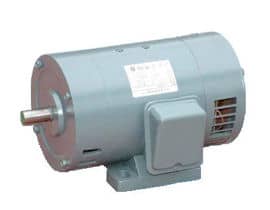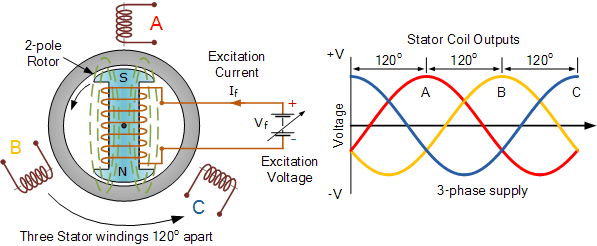
Synchronous Generator
Synchronous Generator as a Wind Power Generator
![]() Like the DC generator in the previous tutorial, the operation of a Synchronous Generator is also based on Faraday’s law of electromagnetic induction, working in a similar fashion to an automotive type alternator.
Like the DC generator in the previous tutorial, the operation of a Synchronous Generator is also based on Faraday’s law of electromagnetic induction, working in a similar fashion to an automotive type alternator.
The difference this time is that the synchronous generator generates a three-phase AC voltage output from its stator windings, unlike the DC generator which produces a single DC or direct current output. Single-phase synchronous generators are also available for low power domestic wind turbine synchronous generator systems.
Basically, the synchronous generator is a synchronous electro-mechanical machine used as a generator and consists of a magnetic field on the rotor that rotates and a stationary stator containing multiple windings that supplies the generated power. The rotors magnetic field system (excitation) is created by using either permanent magnets mounted directly onto the rotor or energised electro-magnetically by an external DC current flowing in the rotor field windings.
This DC field current is transmitted to the synchronous machine’s rotor via slip rings and carbon or graphite brushes. Unlike the previous DC generator design, synchronous generators do not require complex commutation allowing for a simpler construction. Then the synchronous generator operates in a similar way to the automotive car alternator and consists of the two following common parts:
Main Components of a Synchronous Generator
- The Stator: – The stator carries the three separate ( 3-phase ) armature windings physically and electrically displaced from each other by 120 degrees producing an AC voltage output.
- The Rotor: – The rotor carries the magnetic field either as permanent magnets or wound field coils connected to an external DC power source via slip rings and carbon brushes.
When talking about the “synchronous generator”, the terminology used for the description of the machines parts is the reverse to that for the description of the DC generator. The field windings are the windings producing the main magnetic field which are the rotor windings for a synchronous machine, and the armature windings are the windings where the main voltage is induced usually called the stator windings. In other words, for a synchronous machine, the rotor windings are the field windings and the stator windings are the armature windings as shown.
Synchronous Generator Construction

The example above shows the basic construction of a synchronous generator which has a wound salient two-pole rotor. This rotor winding is connected to a DC supply voltage producing a field current, If. The external DC excitation voltage which can be as high as 250 volts DC, produces an electromagnetic field around the coil with static North and South poles.
When the generators rotor shaft is turned by the turbines blades (the prime mover), the rotor poles will also move producing a rotating magnetic field as the North and South poles rotate at the same angular velocity as the turbine blades, (assuming direct drive). As the rotor rotates, its magnetic flux cuts the individual stator coils one by one and by Faraday’s law, an emf and therefore a current is induced in each stator coil.
The magnitude of the voltage induced in the stator winding is, as shown above, a function of the magnetic field intensity which is determined by the field current, the rotating speed of the rotor, and the number of turns in the stator winding. As the synchronous machine has three stator coils, a 3-phase voltage supply corresponding to the windings, A, B and C which are electrically 120o apart is generated in the stator windings and this is shown above.
This 3-phase stator winding is connected directly to the load, and as these coils are stationary they do not need to go through large unreliable slip-rings, commutator or carbon brushes. Also because the main current generating coils are stationary, it makes it easier to wind and insulate the windings because they are not subjected to rotational and centrifugal forces allowing for greater voltages to be generated.
Permanent Magnet Synchronous Generator
As we have seen, wound-field synchronous machines require DC current excitation in the rotor winding. This excitation is done through the use of brushes and slip rings on the generator shaft. However, there are several disadvantages such as requiring regular maintenance, cleaning of the carbon dust, etc. An alternative approach is to use brushless excitation which uses permanent magnets instead of electromagnets.
As its name implies, in a permanent magnet synchronous generator ( PMSG ), the excitation field is created using permanent magnets in the rotor. The permanent magnets can be mounted on the surface of the rotor, embedded into the surface or installed inside the rotor. The air gap between the stator and rotor is reduced for maximum efficiency and to minimise the amount of rare earth magnet material needed. Permanent magnets are typically used in low power, low cost synchronous generators.
For low speed direct drive wind turbine generators the permanent magnet generator is more competitive because it can have higher pole number of 60 or more poles compared to a conventional wound rotor synchronous generator. Also, the excitation implementation with permanent magnets is simpler, more durable but does not allow control of excitation or reactive power. The one major disadvantage of permanent magnet wind turbine synchronous generators is that with no control of the rotor flux, they attain their peak efficiency only at one pre-defined wind speed.
The Generators Synchronous Speed
The frequency of the output voltage depends upon the speed of rotation of the rotor, in other words its “angular velocity”, as well as the number of individual magnetic poles on the rotor. In our simple example above, the synchronous machine has two-poles, one North pole and one South pole. In other words, the machine has two individual poles or one pair of poles, (North-South) also known as pole pairs.
As the rotor rotates one complete revolution, 360o, one cycle of induced emf is generated, so the frequency will be one-cycle every full rotation or 360o. If we double the number of magnetic poles to four, (two pairs of poles), then for every revolution of the rotor, two cycles of induced emf will be generated and so on.
Since one cycle of induced emf is produced with a single pair of poles, the number of cycles of emf produced in one revolution of the rotor will therefore be equal to the number of pole pairs, P. So if the number of cycles per revolution is given as: P/2 relative to the number of poles and the number of rotor revolutions N per second is given as: N/60, then the frequency, ( ƒ ) of the induced emf will be defined as:

In a synchronous moto

